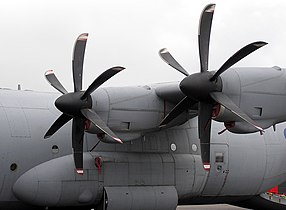Wingtip device


Wingtip devicesare intended to improve the efficiency offixed-wing aircraftby reducingdrag.[1]Although there are several types ofwing tipdevices which function in different manners, their intended effect is always to reduce an aircraft's drag. Wingtip devices can also improve aircraft handling characteristics and enhance safety for following aircraft. Such devices increase the effectiveaspect ratioof a wing without greatly increasing thewingspan.Extending the span would lowerlift-induced drag,but would increaseparasitic dragand would require boosting the strength and weight of the wing. At some point, there is no net benefit from further increased span. There may also be operational considerations that limit the allowable wingspan (e.g., available width atairport gates).
Wingtip devices help prevent the flow around the wingtip of higher pressure air under the wing flowing to the lower pressure surface on top at the wingtip, which results in a vortex caused by the forward motion of the aircraft. Winglets also reduce the lift-induced drag caused bywingtip vorticesand improvelift-to-drag ratio.This increasesfuel efficiencyin powered aircraft and increases cross-country speed ingliders,in both cases increasingrange.[1]U.S. Air Forcestudies indicate that a given improvement in fuel efficiency correlates directly with the causal increase in the aircraft's lift-to-drag ratio.[2]
Early history
[edit]Wing end-plates
[edit]
The initial concept dates back to 1897, when English engineerFrederick W. Lanchesterpatented wing end-plates as a method for controlling wingtip vortices.[3]In the United States, Scottish-born engineerWilliam E. Somervillepatented the first functional winglets in 1910. Somerville installed the devices on his early biplane and monoplane designs.[4]Vincent Burnellireceived US Patent no: 1,774,474 for his "Airfoil Control Means" on August 26, 1930.[5]
Simple flat end-plates did not cause a reduction in drag, because the increase in profile drag was greater than the decrease in induced drag.[6]
Hoerner wing tips
[edit]
Following the end of World War II, Dr.Sighard F. Hoernerwas a pioneer researcher in the field, having written a technical paper published in 1952[7]that called for drooped wingtips whose pointed rear tips focused the resulting wingtip vortex away from the upper wing surface. Drooped wingtips are often called "Hoerner tips" in his honor. Gliders and light aircraft have made use of Hoerner tips for many years.[8][7]
The earliest-known implementation of a Hoerner-style downward-angled "wingtip device" on a jet aircraft was during World War II. This was the so-called "Lippisch-Ohren" (Lippisch-ears), allegedly attributed to theMesserschmitt Me 163's designerAlexander Lippisch,and first added to the M3 and M4 third and fourth prototypes of theHeinkel He 162ASpatzjetlight fighterfor evaluation. This addition was done in order to counteract thedutch rollcharacteristic present in the original He 162 design, related to its wings having a markeddihedral angle.This became a standard feature of the approximately 320 completed He 162A jet fighters built, with hundreds more He 162A airframes going unfinished byV-E Day.[9]
Winglet
[edit]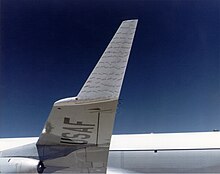

The term "winglet" was previously used to describe an additional lifting surface on an aircraft, like a short section between wheels on fixed undercarriage.Richard Whitcomb'sresearch in the 1970s atNASAfirst used winglet with its modern meaning referring to near-vertical extension of thewing tips.[10]The upward angle (orcant) of the winglet, its inward or outward angle (ortoe), as well as its size and shape are critical for correct performance and are unique in each application. The wingtip vortex, which rotates around from below the wing, strikes thecamberedsurface of the winglet, generating a force that angles inward and slightly forward, analogous to asailboatsailingclose hauled.The winglet converts some of the otherwise-wasted energy in the wingtip vortex to an apparentthrust.This small contribution can be worthwhile over the aircraft's lifetime, provided the benefit offsets the cost of installing and maintaining the winglets.[citation needed]
Another potential benefit of winglets is that they reduce the intensity ofwake vortices.[11]Those trail behind the plane and pose a hazard to other aircraft.[12]Minimum spacing requirements between aircraft operations at airports are largely dictated by these factors. Aircraft areclassified by weight(e.g. "Light", "Heavy", etc.) because the vortex strength grows with the aircraftlift coefficient,and thus, the associated turbulence is greatest at low speed and high weight, which produced a highangle of attack.[citation needed]
Winglets and wingtip fences also increase efficiency by reducing vortex interference with laminar airflow near the tips of the wing,[13]by 'moving' the confluence of low-pressure (over wing) and high-pressure (under wing) air away from the surface of the wing. Wingtip vortices create turbulence, originating at the leading edge of the wingtip and propagating backwards and inboard. This turbulence 'delaminates' the airflow over a small triangular section of the outboard wing, which destroys lift in that area. The fence/winglet drives the area where the vortex forms upward away from the wing surface, since the center of the resulting vortex is now at the tip of the winglet.[citation needed]
Thefuel economyimprovement from winglets increases with the mission length.[14]Blended winglets allow a steeper angle of attack reducingtakeoffdistance.[15]
Early development
[edit]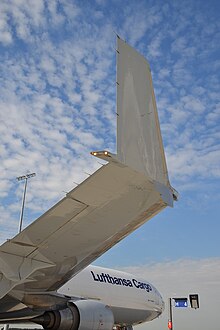
Richard T. Whitcomb,an engineer atNASA'sLangley Research Center,further developed Hoerner's concept in response to the sharp increase in the cost of fuel after the1973 oil crisis.With careful aeronautical design he showed that, for a given bending moment, a near-vertical winglet offers a greater drag reduction compared to a horizontal span extension.[16]Whitcomb's designs were flight-tested in 1979–80 by a joint NASA/Air Force team, using aKC-135 Stratotankerbased at theDryden Flight Research Center.[3]ALockheed L-1011andMcDonnell Douglas DC-10were also used for testing, and the latter design was directly implemented by McDonnell Douglas on the derivativeMD-11,which was rolled out in 1990.[3]
In May 1983, a high school student atBowie High School in Marylandwon a grand prize at the 34thInternational Science and Engineering FairinAlbuquerque, New Mexicofor the result of his research on wingtip devices to reduce drag.[17][importance?]The same month, he filed a U.S. patent for "wingtip airfoils", published in 1986.[18][importance?]
Applications
[edit]NASA
[edit]NASA's most notable application of wingtip devices is on theBoeing 747Shuttle Carrier Aircraft.Located on the 747's horizontal stabilizers, the devices increase the tailplane's effectiveness under the weight of theSpace Shuttle orbiter,[10]though these were more for directional stability than for drag reduction.[relevant?]
Business aircraft
[edit]
Learjet exhibited the prototypeLearjet 28at the 1977National Business Aviation Associationconvention. It employed the first winglets ever used on a production aircraft, either civilian or military. Learjet developed the winglet design without NASA assistance. Although the Model 28 was intended to be a prototype experimental aircraft, performance was such that it resulted in a production commitment from Learjet. Flight tests showed that the winglets increased range by about 6.5 percent and improved directional stability. Learjet's application of winglets to production aircraft continued with newer models including theLearjet 55,31,60,45,andLearjet 40.
Gulfstream Aerospaceexplored winglets in the late 1970s and incorporated winglets in theGulfstream III,Gulfstream IVandGulfstream V.The Gulfstream Vrangeof 6,500 nmi (12,000 km) allows nonstop routes such as New York–Tokyo, it holds over 70 world and national flight records.[3] The Rutan combined winglets-vertical stabilizer appeared on hisBeechcraft Starshipbusiness aircraft design that first flew in 1986.
Winglets are also applied to other business aircraft, reducing take-off distance to operate from smaller airports, and allowing higher cruise altitudes. Along winglets on new designs, aftermarket vendors developed retrofits. Winglet Technology, LLC ofWichita, Kansasshould have tested its elliptical winglets designed to increasepayload-rangeonhot and highdepartures to retrofit theCitation X.[19]
Experimental
[edit]Conventional winglets were fitted to Rutan'sRutan Voyager,the first aircraft to circumnavigate the world without refueling in 1986. The aircraft's wingtips were damaged, however, when they dragged along the runway during takeoff, removing about 1 foot (30 cm) from each wingtip, so the flight was made without benefit of winglets.[20]
Airliner fuel efficiency
[edit]The average commercial jet sees a 4-6 percent increase in fuel efficiency and as much as a 6% decrease in in-flight noise from the use of winglets. Actual fuel savings and the related carbon output can vary significantly by plane, route and flight conditions.[21]
Wingtip fence
[edit]A wingtip fence refers to the winglets including surfaces extending both above and below the wingtip, as described in Whitcomb's early research.[10]Both surfaces are shorter than or equivalent to a winglet possessing similar aerodynamic benefits. TheAirbus A310-300was the first airliner with wingtip fences in 1985.[22]Other Airbus models followed with theA300-600,theA320ceo,and theA380.Other Airbus models including theAirbus A320 Enhanced,A320neo,A350andA330neohave blended winglets rather than wingtip fences. TheAntonov An-148uses wingtip fences.
Canted winglets
[edit]Boeingannounced a new version of the747,the747-400,in 1985, with an extended range and capacity, using a combination of winglets and increased span to carry the additional load. The winglets increased the 747-400's range by 3.5% over the 747-300, which is otherwise aerodynamically identical but has no winglets. The 747-400D variant lacks the wingtip extensions and winglets included on other 747-400s since winglets would provide minimal benefits on short-haul routes while adding extra weight and cost, although the -400D may be converted to the long-range version if needed.[1]Winglets are preferred for Boeing derivative designs based on existing platforms, because they allow maximum re-use of existing components. Newer designs are favoring increased span, other wingtip devices or a combination of both, whenever possible.[citation needed]
TheIlyushin Il-96was the first Russian and modern jet to feature winglets in 1988. TheBombardier CRJ-100/200 was the first regional airliner to feature winglets in 1992. TheA340/A330followed with canted winglets in 1993/1994. TheTupolev Tu-204was the firstnarrowbodyaircraft to feature winglets in 1994. TheAirbus A220(née CSeries), from 2016, has canted winglets.
Blended winglets
[edit]A blended winglet is attached to the wing with a smooth curve instead of a sharp angle and is intended to reduceinterference dragat the wing/winglet junction. A sharp interior angle in this region can interact with theboundary layerflow causing a drag inducing vortex, negating some of the benefit of the winglet.Seattle-basedAviation Partnersdevelops blended winglets as retrofits for theGulfstream II,Hawker 800and theFalcon 2000.
-
Boeing 747-400canted winglet
-
Airbus A320sharklet (blended winglet)
-
Boeing 767-400ERwith raked wingtips
-
Airbus A310-300wingtip fence
On February 18, 2000, blended winglets were announced as an option for theBoeing 737-800;the first shipset was installed on 14 February 2001 and entered revenue service withHapag-Lloyd Flugon 8 May 2001.[23]The Aviation Partners/Boeing 8 ft (2.4 m) extensions decreasefuel consumptionby 4% for long-range flights and increase range by 130 or 200 nmi (240 or 370 km) for the 737-800 or the derivativeBoeing Business Jetas standard.[1]Also offered for the737 Classic,many operators have retrofitted their fleets with these for the fuel savings.[citation needed]Aviation Partners Boeing also offers blended winglets for the757and767-300ER.[24]In 2006 Airbus tested two candidate blended winglets, designed by Winglet Technology and Airbus for theAirbus A320 family.[25]In 2009 Airbus launched its "Sharklet" blended winglet, designed to enhance thepayload-rangeof itsA320 familyand reduce fuel burn by up to 4% over longer sectors.[26]This corresponds to an annual CO2reduction of 700 tonnes per aircraft.[27]The A320s fitted with Sharklets were delivered beginning in 2012.[28][29]They are used on theA320neo,theA330neoand theA350.They are also offered as a retrofit option.[29][30]
Raked wingtip
[edit]Raked wingtips, where the tip has a greaterwing sweepthan the rest of the wing, are featured on someBoeing Commercial Airplanesto improvefuel efficiency,takeoff and climb performance. Like winglets, they increase the effectivewing aspect ratioand diminishwingtip vortices,decreasing lift-induced drag. In testing by Boeing and NASA, they reduce drag by as much as 5.5%, compared to 3.5% to 4.5% for conventional winglets.[1]While an increase in span would be more effective than a same-length winglet, itsbending momentis greater. A 3 ft (91 cm) winglet gives the performance gain of a 2 ft (61 cm) span increase but has the bending force of a 1 ft (30 cm) span increase.[31]
Raked wingtips offer several weight-reduction advantages relative to simply extending the conventional mainwingspan.At high load-factor structural design conditions, the smallerchordsof the wingtip are subjected to less load, and they result in less induced loading on the outboard main wing. Additionally, the leading-edgesweepresults in thecenter of pressurebeing located farther aft than for simple extensions of the span of conventional main wings. At high load factors, this relative aft location of the center of pressure causes the raked wingtip to be twisted more leading-edge down, reducing the bending moment on the inboard wing. However, the relative aft-movement of the center of pressure accentuatesflutter.[32]
Raked wingtips are installed on theBoeing 767-400ER (first flight on October 9, 1999), all generations ofBoeing 777(June 12, 1994) including the upcoming777X,the 737-derivedBoeing P-8 Poseidon(25 April 2009), all variants of theBoeing 787(December 15, 2009) (the cancelledBoeing 787-3would have had a 170 ft (51.7 m) wingspan to fit inICAO Aerodrome Reference CodeD, as its wingspan was decreased by using blended winglets instead of raked wingtips[33]), and theBoeing 747-8(February 8, 2010). The EmbraerE-jet E2andC-390 Millenniumwings also have raked wingtips.
Split-tip
[edit]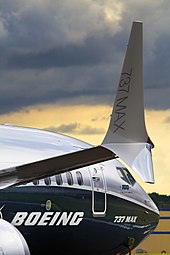
TheMcDonnell Douglas MD-11was the first aircraft with split-tip winglets in 1990.
For the737 Next Generation,third-party vendorAviation Partnershas introduced a similar design to the 737 MAX wingtip device known as the split scimitar winglet,[34]withUnited Airlinesas the launch customer.[35]
TheBoeing 737 MAXuses a new type of wingtip device.[36]Resembling a three-way hybrid of a winglet, wingtip fence, and raked wingtip, Boeing claims that this new design should deliver an additional 1.5% improvement in fuel economy over the 10-12% improvement already expected from the 737 MAX.
Gliders
[edit]
In 1987,mechanical engineerPeter Masakcalled on aerodynamicistMark D. Maughmer,an associate professor of aerospace engineering at thePennsylvania State University,about designing winglets to improve performance on his 15-meter (49 ft) wingspan racingsailplane.Others had attempted to apply Whitcomb's winglets to gliders before, and they did improve climb performance, but this did not offset the parasitic drag penalty in high-speed cruise. Masak was convinced it was possible to overcome this hurdle.[37]By trial and error, they ultimately developed successful winglet designs forgliding competitions,using a new PSU–90–125airfoil,designed by Maughmer specifically for the winglet application. At the 1991World Gliding ChampionshipsinUvalde, Texas,the trophy for the highest speed went to a winglet-equipped 15-meter class limited wingspan glider, exceeding the highest speed in the unlimited spanOpen Class,an exceptional result.[38]Masak went on to win the 1993 U.S. 15 Meter Nationals gliding competition, using winglets on his prototypeMasak Scimitar.[39]

The Masak winglets were originally retrofitted to production sailplanes, but within 10 years of their introduction, most high-performance gliders were equipped from the factory with winglets or other wingtip devices.[40]It took over a decade for winglets to first appear on a production airliner, the original application that was the focus of the NASA development. Yet, once the advantages of winglets were proven in competition, adoption was swift with gliders. The point difference between the winner and the runner-up in soaring competition is often less than one percent, so even a small improvement in efficiency is a significant competitive advantage. Many non-competition pilots fitted winglets for handling benefits such as increasedroll rateand roll authority and reduced tendency for wing tipstall.The benefits are notable, because sailplane winglets must be removable to allow the glider to be stored in atrailer,so they are usually installed only at the pilot's preference.[citation needed]
TheGlaser-Dirks DG-303,an early glider derivative design, incorporating winglets as factory standard equipment.
Non-planar wingtip
[edit]
Aviation Partnersdeveloped and flight tested aclosed-surfaceSpiroid winglet on aFalcon 50in 2010.[41]
Non-planar wingtips are normally angled upwards in a polyhedral wing configuration, increasing the localdihedralnear the wing tip, with polyhedral wing designs themselves having been popular onfree-flightmodel aircraft designs for decades. Non-planar wingtips provide the wake control benefit of winglets, with less parasitic drag penalty, if designed carefully. The non-planar wing tip is often swept back like araked wingtipand may also be combined with awinglet.A winglet is also a special case of a non-planar wingtip.[citation needed]
Aircraft designers employed mostly planar wing designs with simple dihedral after World War II, prior to the introduction of winglets. With the wide acceptance of winglets in new sailplane designs of the 1990s, designers sought to further optimize the aerodynamic performance of their wingtip designs. Glider winglets were originally retrofitted directly to planar wings, with only a small, nearly right-angle, transition area. Once the performance of the winglet itself was optimized, attention was turned to the transition between the wing and winglet. A common application was tapering the transition area from the wing tipchordto the winglet chord and raking the transition area back, to place the winglet in the optimal position. If the tapered portion was canted upward, the winglet height could also be reduced. Eventually, designers employed multiple non-planar sections, each canting up at a greater angle, dispensing with the winglets entirely.[citation needed]
TheSchempp-Hirth Discus-2andSchempp-Hirth Duo Discususe non-planar wingtips.
Active wingtip device
[edit]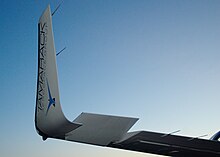
Tamarack Aerospace Group, a company founded in 2010 by aerospace structural engineer Nicholas Guida, has patented an Active Technology Load Alleviation System (ATLAS), a modified version of a wingtip device.[42]The system uses Tamarack Active Camber Surfaces (TACS) to aerodynamically "switch off" the effects of the wingtip device when the aircraft is experiencing high-g events such as large gusts or severe pull-ups. TACS are movable panels, similar toflapsorailerons,on the trailing edge of the wing extension.[42][43]The system is controlled by the aircraft's electrical system and a high-speedservowhich is activated when the aircraft senses an oncoming stress event, essentially simulating an actuating wingtip. However, the wingtip itself is fixed and the TACS are the only moving part of the wingtip system. Tamarack first introduced ATLAS for theCessna Citation familyaircraft,[42][43]and it has been certified for use by theFederal Aviation AdministrationandEuropean Union Aviation Safety Agency.[44][45]
Actuating wingtip device
[edit]There has been research into actuating wingtip devices, including a filed patent application,[46]though no aircraft currently uses this feature as described. TheXB-70 Valkyrie's wingtips were capable of drooping downward in flight, to facilitateMach 3flight usingwaveriding.
Use on rotating blades
[edit]Wingtip devices are also used on rotatingpropeller,helicopter rotor,andwind turbineblades to reduce drag, reduce diameter, reduce noise and/or improve efficiency. By reducing aircraft blade tip vortices interacting with the ground surface duringtaxiing,takeoff,andhover,these devices can reduce damage from dirt and small stones picked up in the vortices.[47]
-
AgustaWestland AW101Merlin showingBERP rotorwith distinctive blade tip profile
-
C-130J Super Herculesshowingscimitar propellerswith raked tips
-
Detail view of the wingtip device on a wind turbine rotor-blade
-
Ceiling fan with wingtip devices
Rotorcraft applications
[edit]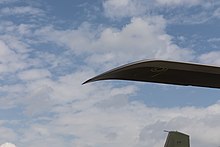
The main rotor blades of theAgustaWestland AW101(formerly the EH101) have a distinctive tip shape; pilots have found that this rotor design alters the downwash field and reducesbrownoutwhich limits visibility in dusty areas and leads to accidents.[48]
Propeller applications
[edit]Hartzell Propellerdeveloped their "Q-tip" propeller used on thePiper PA-42 Cheyenneand several other fixed-wing aircraft types by bending the blade tips back at a 90-degree angle to get the samethrustfrom a reduced diameter propeller disk; the reduced propeller tip speed reduces noise, according to the manufacturer.[47]Modernscimitar propellershave increasedsweepbackat the tips, resembling a raked tip on an aircraft wing.
Other applications
[edit]Someceiling fanshave wingtip devices. Fan manufacturerBig Ass Fanshas claimed that their Isis fan, equipped with wingtip devices, has superior efficiency.[49]However, for certain high-volume, low-speed designs, wingtip devices may not improve efficiency.[50] Another application of the same principle was introduced to the keel of the "America's Cup" - winning Australian yachtAustralia IIof 1982, designed byBen Lexcen.
References
[edit]- ^abcdeRobert Faye, Robert Laprete, Michael Winter (January 2002)."Blended winglets for improved airplane performance"(PDF).Aero magazine.No. 17. Boeing.
{{cite magazine}}:CS1 maint: multiple names: authors list (link) - ^Committee on Assessment of Aircraft Winglets for Large Aircraft Fuel Efficiency (2007).Assessment of Wingtip Modifications to Increase the Fuel Efficiency of Air Force Aircraft.National Academies Press. p. 33.ISBN978-0-309-38382-0.
{{cite book}}:|work=ignored (help)[permanent dead link] - ^abcdJoseph R. Chambers (2003)."Winglets"(PDF).Concept to Reality: Contributions of the Langley Research Center to US Civil Aircraft of the 1990s.NASA Langley Research Center.p. 35.ISBN1493656783.
- ^"2010 Inductees".Illinois Aviation Hall Of Fame. William E. "Billie" Somerville 1869–1950.
- ^US 1774474,Vincent J Burnelli, "Airfoil control means", published 26 Aug 1930
- ^McLean, Doug (2005)."Wingtip Devices: What They Do and How They Do It"(PDF).2005 Performance and Flight Operations Engineering Conference.Boeing: Article 4.RetrievedMarch 27,2022.
- ^abHoerner, Dr. Sighard (1952)."Aerodynamic Shape of the Wing Tips"(PDF).USAF Technical Reports.Engineering Division, Air Materiel Command; Wright-Patterson Air Force Base, Dayton, Ohio; United States Air Force archive. Technical Report No. 5752.Archived(PDF)from the original on March 16, 2013.
- ^Sakrison, David (2004)."A German aerodynamicist, a California character, and a corkscrew".Met-Co-Aire.Archivedfrom the original on March 22, 2016.
- ^Creek, J. Richard; Conway, William (1972) [1967].The Heinkel He 162 (Aircraft in Profile number 203).Leatherhead, Surrey UK: Profile Publications Ltd. p. 5. Archived fromthe originalon August 19, 2013.RetrievedJune 18,2014.
- ^abcBargsten, Clayton J.; Gibson, Malcolm T. (August 2011).NASA Innovation in Aeronautics: Select Technologies That Have Shaped Modern Aviation(PDF).National Aeronautics and Space Administration.pp. 11–22. Archived fromthe original(PDF)on September 21, 2021.RetrievedNovember 1,2017.
- ^Richard T. Witcomb (1976),A design approach and selected wind-tunnel results at high subsonic speeds for wing-tip mounted winglets(PDF),NASA
- ^"Chapter 2"(PDF),London City Airport Wake Turbulence Study,Halcrow Group Limited, December 2010, archived from the original on October 1, 2017
{{citation}}:CS1 maint: bot: original URL status unknown (link) - ^Phil Croucher (2005).Jar Professional Pilot Studies.Electrocution. pp. 2–11.ISBN978-0-9681928-2-5.
- ^William Freitag, Terry Schulze (Summer 2009)."Blended Winglets Improve Performance"(PDF).Aero quarterly.Boeing. pp. 9–12.
- ^"Winglets allow for steeper climbs"(PDF).FACC AG. Archived fromthe original(PDF)on November 7, 2017.RetrievedJanuary 6,2019.
- ^McLean, Doug (2013).Understanding aerodynamics: arguing from the real physics.Chichester: Wiley-Blackwell. p. 422.ISBN978-1119967514.
- ^Wynter, Leon (May 18, 1983)."Bowie Youth Sweeps Science 'World Series'".Washington Post.
- ^patentUS 4595160
- ^"Winglets Coming For Citation X Bizjets".Aero news network.March 13, 2007.
- ^"Dick Rutan, Jeana Yeager, and the Flight of the Voyager".U.S. Centennial of Flight Commission.
- ^"The impact of winglets on fuel consumption and aircraft emissions".Cirium.RetrievedAugust 2,2022.
- ^"From the A300 to the A380: Pioneering leadership".Corporate information – Innovation & technology.Airbus. Archived from the original on April 21, 2009.
{{cite web}}:CS1 maint: bot: original URL status unknown (link) - ^"Next-Generation 737 Program Milestones".Boeing. Archived fromthe originalon April 29, 2008.RetrievedFebruary 5,2019.
- ^Guy Norris (February 23, 2009)."American Airlines Set To Debut 767 Winglet Mod".Aviation Week & Space Technology.p. 39.
- ^"Industry Wrap".Frontiers.Vol. 4, no. 10. Boeing. March 2006. Airbus to test new winglets for single-aisle jetliners.
- ^"American Airlines takes delivery of its first A320 Family aircraft"(Press release). Airbus. July 23, 2013. Archived fromthe originalon November 7, 2017.RetrievedNovember 1,2017.
- ^"Korean Air Aerospace to manufacture and distribute Sharklets"(Press release). Airbus. May 31, 2010.
- ^"Airbus launches" Sharklet "large wingtip devices for A320 Family with commitment from Air New Zealand".Airbus.November 15, 2009. Archived fromthe originalon November 7, 2017.
- ^abGardiner, Ginger (May 1, 2014)."First A320neo features composite Korean Sharklets".CompositesWorld.RetrievedSeptember 9,2020.
- ^"Airbus Selects Korean Air Aerospace to manufacture Sharklet wingtips for the A330neo Family".Airbus.Archived fromthe originalon January 26, 2023.RetrievedSeptember 9,2020.
- ^George C. Larson (September 2001)."How Things Work: Winglets".Air & Space Magazine.Smithsonian.
- ^Herrick, Larry (June 12, 1998)."Blunt Leading-Edge Raked Wingtips"(PDF).Google Patents.RetrievedDecember 6,2021.
- ^Rich Breuhaus (May 20, 2008)."787 Dreamliner: A New Airplane for a New World"(PDF).ACI-NA Commissioners Conference.Boeing. Archived fromthe original(PDF)on March 7, 2017.RetrievedJanuary 6,2019.
- ^"737-800-3".Aviation Partners Boeing.
- ^"United is first to install Split Scimitar winglets"(Press release). United Airlines. July 17, 2013.
- ^Matt Molnar (May 2, 2012)."Boeing Says Radical New Winglets on 737 MAX Will Save More Fuel".NYCAviation.
- ^Curtis Chan (Summer 2000)."The tip of the iceberg".Engineering Penn State magazine.Archived from the original on June 11, 2004.
{{cite web}}:CS1 maint: bot: original URL status unknown (link) - ^Masak, Peter (April–May 1992)."Winglet Design for Sailplanes"(PDF).Free Flight.1992(2): 8.ISSN0827-2557.
- ^"Past Mifflin Contests".Mifflin Soaring Association.
- ^Mark D. Maughmer(June 2002)."About Winglets"(PDF).Soaring Magazine.
- ^"Types of blended winglets".Aviation Partners.
- ^abcGerzanics, Mike (October 23, 2019)."ANALYSIS: ATLAS Citation separates winglet from 'blinglet'".Flight Global.RetrievedSeptember 9,2020.
- ^abUS patent 7900877B1,Guida, Nicholas R., "Active winglet", published 2011-03-08, issued 2010-09-24
- ^Bergqvist, Pia (February 6, 2018)."Tamarack Active Winglets Certified for Citation 525 Series".Flying.RetrievedSeptember 9,2020.
- ^Finfrock, Rob (July 8, 2019)."EASA Approves Tamarack Fixes To Lift Atlas Emergency AD".Aviation International News.RetrievedSeptember 9,2020.
- ^ EP 1531126,Jan Irving & Robert Davies, "Wing tip device", published 2005-05-18, assigned to Airbus
- ^ab"What is a Q-Tip propeller? What are its advantages?".Product Support: Frequently Asked Questions.Hartzell Propeller.Archived from the original on March 18, 2001.
Aerodynamic improvements include a reduced diameter and decreased tip speeds. This results in quieter operation and reduced tip vortices. The 90° bend reduces the vortices that, on traditional blades, pick up debris that can contact the blades and cause nicks, gouges and scratches.
{{cite web}}:CS1 maint: bot: original URL status unknown (link) - ^Harvey, Gareth (November 28, 2005)."Super Chopper: Life-Saving Features: No More Brown-Outs".Engineering Archives.National Geographic Channel. Archived fromthe originalon July 21, 2009.RetrievedAugust 1,2009.
To counteract this, the EH101's 'winged-tip' rotor blades create what its pilots call the "donut effect" – a circular window of clear air inside the dust storm that allows them to see the ground as they come in to land.
- ^Nino Machetti (May 10, 2010)."Isis ceiling fan claims higher efficiency".EarthTechling.
- ^Eddie Boyd (February 4, 2014)."Winglets: Help or Hindrance to HVLS Fan Performance?".MacroAir.
External links
[edit]- Peter Masak(1991)."Winglet Design for Sailplanes".
- Martin Hepperle (May 1993)."A close Look at Winglets".International Nurflügelmeeting des MFC Osnabrück.
- "Winglet benefits".Flight International.May 1, 1996. Winglets could bring operational benefits to the Boeing 747-200F.
- "New Boeing 777-300ER Bristles with Technology"(Press release). Boeing. October 16, 2003.
- Joe Yoon (November 2, 2003)."Boeing 767 Raked Wingtips".Aerospaceweb.org.
- "Winglets: making their presence felt"(PDF).Aircraft Technology Engineering & Maintenance.April–May 2004.
- Doug McLean (2005)."Wingtip Devices: What They Do and How They Do It"(PDF).Performance and Flight Operations Engineering Conference.Boeing.
- "The benefits of winglets and performance enhancing kits"(PDF).Aircraft Commerce.No. 109. December 2016 – January 2017.






